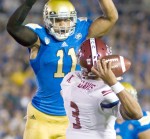Last season, Anthony Barr laid a hit that was heard around the city – a sack so thunderous under the rain at the Rose Bowl it ended USC quarterback Matt Barkley’s college career.
On Sept. 21, the senior outside linebacker rocked New Mexico State quarterback King Davis III to bed in almost identical fashion. This time, he was flagged for roughing the passer and the Aggies got a fresh set of downs and 15 yards.
The call seemed harsh – the hit looked clean as Barr leveled Davis III square in the chest just as the quarterback was letting go of the ball. A great play of course, but very normal in its delivery.
And while many saw the referees’ decision and the subsequent penalty as unneeded, broadcasters called for something even more severe – a flag for targeting.
Targeting results in a 15-yard penalty much like that of a roughing-the-passer flag but because of a new rule being implemented by the NCAA this season, players penalized for targeting will be automatically ejected as well. The ejection serves to attempt to discourage players from making dangerous hits to the head of opposing players with the crowns of their helmets.
Players flagged in the first half of the game will be ejected for the remainder of the game. Players flagged in the second half of the game, as Barr was, will be ejected for the remainder of the game along with the first half of the following game.
If the referees had agreed with the broadcasters, UCLA’s best defensive playmaker would have been ineligible for the rest of this game – which probably wouldn’t have mattered all that much with the Bruins up 31-nil. But if Barr would have had to miss the entire first half of UCLA’s conference at a hostile environment in Utah, you’d be looking at an entirely different game – all on a blown call.
That yellow flag suddenly becomes almost like a red card.
Earlier in the game, the Bruins had their first experience with the new targeting rule as redshirt senior wide receiver Shaquelle Evans took a shot to the head while defenseless from the helmet of a New Mexico State defensive back.
Evans agreed with the targeting flag, even calling the hit “malicious,” but conceded that an ejection and suspension were unnecessary.
The rule is well intended, discouraging players from using their heads as the point of contact for a tackle, but too ambiguously enforced.
The differences between a no-call to a roughing-the-passer penalty to a targeting flag are all too subtle and could not only influence the game the player is ejected from but the next one as well. It’s a lot at stake on a split-second decision made by a ref on a rule with much ambiguity.
The targeting call is meant to ensure player safety but in the spur of the moment, instincts take over and players do what they’re accustomed to, which is often the bad technique of lowering their heads.
Coach Jim Mora sees a different solution to the problem: changing those instincts.
“It’s easy when you watch it on film and you slow it down and analyze it, but things are happening so fast on the field, it’s something you just have to constantly talk to your players about and you have to drill it,” he said. “Every tackling drill that you do you have to talk about lowering the target and keeping your head up. That’s not just for your opponent, that’s good tackling mechanics.”
As for the the hit on Davis III, Mora offers yet another suggestion.
“You should probably just block Anthony Barr; he’s a pretty good player.”
